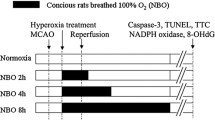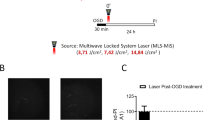We studied the effect of 2-h inhalation of argon-oxygen mixture (Ar 70%/O2 30%) after photochemically induced stroke and on days 2 and 3 after stroke modeling on the severity of neurological deficit and brain damage (by MRI data) in Wistar rats. Neurological deficit was assessed within 14 days using the limb placement test. MRI and histological study of the brain with an assessment of the size of damage were performed on day 14 after ischemia. Significant differences were obtained in limb placement scores on days 3, 7, and 14, as well as in the volume of ischemic focus by MRI in comparison with the control (ischemia+N2 70%/O2 30%). Inhalation of argon-oxygen mixture for 2 h a day over 3 days after photoinduced stroke decreased the volume of brain damage by 2 times and reduced the severity of neurological deficit.
Similar content being viewed by others
References
Gur’eva TS, Dadasheva OA, Soldatov PE, Sychev VN, Mednikova EI, Smirnov IA, Smolenskaia TS, Dadasheva MT. Effect of hypoxic argon-containing gas mixtures on developing organism. Aviakosm. Ekolog. Med. 2008;42(4):40-43.
Moro F, Fossi F, Magliocca A, Pascente R, Sammali E, Baldini F, Tolomeo D, Micotti E, Citerio G, Stocchetti N, Fumagalli F, Magnoni S, Latini R, Ristagno G, Zanier ER. Efficacy of acute administration of inhaled argon on traumatic brain injury in mice. Br. J. Anaesth. 2021;126(1):256-264. doi: https://doi.org/10.1016/j.bja.2020.08.027
Ulbrich F, Kaufmann K, Roesslein M, Wellner F, Auwärter V, Kempf J, Loop T, Buerkle H, Goebel U. Argon Mediates Anti-Apoptotic Signaling and Neuroprotection via Inhibition of Toll-Like Receptor 2 and 4. PLoS One. 2015;10(12):e0143887. doi: https://doi.org/10.1371/journal.pone.0143887
Harris K, Armstrong SP, Campos-Pires R, Kiru L, Franks NP, Dickinson R. Neuroprotection against traumatic brain injury by xenon, but not argon, is mediated by inhibition at the N-methyl-D-aspartate receptor glycine site. Anesthesiology. 2013;119(5):1137-1148. doi: https://doi.org/10.1097/ALN.0b013e3182a2a265
Grüßer L, Blaumeiser-Debarry R, Krings M, Kremer B, Höllig A, Rossaint R, Coburn M. Argon attenuates the emergence of secondary injury after traumatic brain injury within a 2-hour incubation period compared to desflurane: an in vitro study. Med. Gas Res. 2017;7(2):93-100. doi: https://doi.org/10.4103/2045-9912.208512
Creed J, Cantillana-Riquelme V, Yan BH, Ma S, Chu D, Wang H, Turner DA, Laskowitz DT, Hoffmann U. Argon inhalation for 24 h after closed-head injury does not improve recovery, neuroinflammation, or neurologic outcome in mice. Neurocrit. Care. 2021;34(3):833-843. doi: https://doi.org/10.1007/s12028-020-01104-0
Kim Y, Lee YB, Bae SK, Oh SS, Choi JR. Development of a photochemical thrombosis investigation system to obtain a rabbit ischemic stroke model. Sci. Rep. 2021;11(1):5787. doi: https://doi.org/10.1038/s41598-021-85348-6
Macrae IM. Preclinical stroke research — advantages and disadvantages of the most common rodent models of focal ischaemia. Br. J. Pharmacol. 2011;164(4):1062-1078. doi: https://doi.org/10.1111/j.1476-5381.2011.01398.x
Lemoine S, Blanchart K, Souplis M, Lemaitre A, Legallois D, Coulbault L, Simard C, Allouche S, Abraini JH, Hanouz JL, Rouet R, Sallé L, Guinamard R, Manrique A. Argon exposure induces postconditioning in myocardial ischemia-reperfusion. J. Cardiovasc. Pharmacol. Ther. 2017;22(6):564-573. doi: https://doi.org/10.1177/1074248417702891
Silachev DN, Uchevatkin AA, Pirogov YA, Zorov DB, Isaev NK. Comparative evaluation of two methods for studies of experimental focal ischemia: magnetic resonance tomography and triphenyltetrazoleum detection of brain injuries. Bull. Exp. Biol. Med. 2009;147(2):269-272. doi: https://doi.org/10.1007/s10517-009-0489-z
De Ryck M, Van Reempts J, Borgers M, Wauquier A, Janssen PA. Photochemical stroke model: flunarizine prevents sensorimotor deficits after neocortical infarcts in rats. Stroke. 1989;20(10):1383-1390. doi: https://doi.org/10.1161/01.str.20.10.1383.
Jolkkonen J, Puurunen K, Rantakömi S, Härkönen A, Haapalinna A, Sivenius J. Behavioral effects of the alpha(2)-adrenoceptor antagonist, atipamezole, after focal cerebral ischemia in rats. Eur. J. Pharmacol. 2000;400(2-3):211-219. doi: https://doi.org/10.1016/s0014-2999(00)00409-x
David HN, Haelewyn B, Degoulet M, Colomb DGJr, Risso JJ, Abraini JH. Ex vivo and in vivo neuroprotection induced by argon when given after an excitotoxic or ischemic insult. PLoS One. 2012;7(2):e30934. doi: https://doi.org/10.1371/journal.pone.0030934
Ma S, Chu D, Li L, Creed JA, Ryang YM, Sheng H, Yang W, Warner DS, Turner DA, Hoffmann U. Argon inhalation for 24 hours after onset of permanent focal cerebral ischemia in rats provides neuroprotection and improves neurologic outcome. Crit. Care Med. 2019;47(8):e693-e699. doi: https://doi.org/10.1097/CCM.0000000000003809
Fahlenkamp AV, Coburn M, de Prada A, Gereitzig N, Beyer C, Haase H, Rossaint R, Gempt J, Ryang YM. Expression analysis following argon treatment in an in vivo model of transient middle cerebral artery occlusion in rats. Med. Gas Res. 2014;4:11. doi: https://doi.org/10.1186/2045-9912-4-11
Koziakova M, Harris K, Edge CJ, Franks NP, White IL, Dickinson R. Noble gas neuroprotection: xenon and argon protect against hypoxic-ischaemic injury in rat hippocampus in vitro via distinct mechanisms. Br. J. Anaesth. 2019;123(5):601-609. doi: https://doi.org/10.1016/j.bja.2019.07.010
Ulbrich F, Schallner N, Coburn M, Loop T, Lagrèze WA, Biermann J, Goebel U. Argon inhalation attenuates retinal apoptosis after ischemia/reperfusion injury in a time- and dose-dependent manner in rats. PLoS One. 2014;9(12):e115984. doi: https://doi.org/10.1371/journal.pone.0115984
Ershov AV, Krukov IA, Antonova VV, Baeva AA. The effect of xenon on the activity of glycogen synthase kinase-3β in the perifocal zone of ischemic cerebral infarction (experimental study). Obshch. Reanimatol. 2023;19(2):60-67. Russian. doi: https://doi.org/10.15360/1813-9779-2023-2-2274
Makarieva LM, Akulinin VA, Korzhuk MS, Stepanov SS, Shoronova AY, Avdeev DB, Tsuskman IG. Structural and functional reorganization of the sensorimotor cortex during ligation of the common carotid arteries (experimental study). Obshch. Reanimatol. 2022;18(5):32-43. Russian. doi: https://doi.org/10.15360/1813-9779-2022-5-32-43
Gorbunova AV, Avdeev DB, Stepanov SS, Akulinin VA, Stepanov AS, Shoronova AYu, Samsonov AA. Glial cell architecture dynamics in dentate gyrus and CA4 area of Wistar rat hippocampus following 20-minute occlusion of common carotid arteries. Obshch. Reanimatol. 2019;15(6):26-37. Russian. doi: https://doi.org/10.15360/1813-9779-2019-6-26-37
Author information
Authors and Affiliations
Corresponding author
Additional information
Translated from Byulleten’ Eksperimental’noi Biologii i Meditsiny, Vol. 176, No. 8, pp. 167-174, August, 2023
Rights and permissions
Springer Nature or its licensor (e.g. a society or other partner) holds exclusive rights to this article under a publishing agreement with the author(s) or other rightsholder(s); author self-archiving of the accepted manuscript version of this article is solely governed by the terms of such publishing agreement and applicable law.
About this article
Cite this article
Silachev, D.N., Boeva, E.A., Yakupova, E.I. et al. Positive Neuroprotective Effect of Argon Inhalation after Photochemically Induced Ischemic Stroke Model in Rats. Bull Exp Biol Med 176, 143–149 (2023). https://doi.org/10.1007/s10517-024-05984-6
Received:
Published:
Issue Date:
DOI: https://doi.org/10.1007/s10517-024-05984-6




